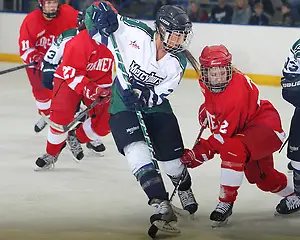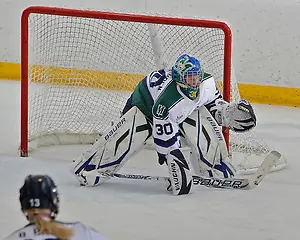The United States is ready to take the ice in the 2012 IIHF World Junior Championship as a two-time defending medalist. After capturing gold in dramatic fashion in Saskatoon, Saskatchewan, in 2010, Team USA earned a bronze medal on quasi-home ice in Buffalo, N.Y., last year.
With all that glory in the past now, if this year’s team hopes to pull off a trifecta of medals (which would be a first for the U.S.) it will have to beat some pretty stiff competition.
Team USA has drawn a difficult bracket for pool play. Of the five teams in Group B — Canada, the Czech Republic, Denmark, Finland and the U.S. — only three will advance to medal play.
Recent history dictates that Canada, the host, and the Czech Republic are all but shoo-ins to emerge from pool play. That reasoning would leave one final spot for Denmark (moving up from the Group A championship in 2011), Finland and the U.S.
It shouldn’t be surprising, then, that when USA Hockey announced its final roster on Thursday morning, it unveiled one laden with experience and older players. Nineteen of the 22 players are in their final year of under-20 eligibility.
“We tried to select 22 players who can best [compete],” said Team USA general manager Jim Johannson. “When people see our team play, they’re going to see a team that plays at a high tempo, that competes all over the ice and is a fundamentally sound team that does the right thing to win hockey games. That’s what you have to do at this championship.”
In addition to being quite possibly the oldest U.S. team in the tournament’s history, there will be a wealth of returning experience. Seven players — led by goaltender Jack Campbell, who has played in each of the last two tournaments — return from last year’s squad.
“Every year you want to have the leadership, and that has to come from our seven returning players,” said Team USA and Nebraska-Omaha coach Dean Blais. “That dressing room straightens out and if there are any problems those captains and your leaders are the ones to straighten it out.”
Assessing the competition, Blais wasn’t giving away many secrets but also made obvious the fact that no opponent in the pool could go overlooked. Otherwise, the U.S. may be on the outside looking in for the medal round.
Blais said simply that Denmark is a team that his staff doesn’t know a lot about. There will be limited opportunity to scout the team as it is the USA’s opening opponent on Dec. 26.
As for those with more familiarity, Blais said that Finland is a team that is “always competitive and hardworking.” The U.S. played against Finland in Lake Placid, N.Y., during an evaluation camp this past summer. Blais watched as they narrowly lost to Canada last year 3-1 in the preliminary round of the World Juniors and, as he recalls, “gave them everything they could handle.”
He says that his staff will scout the Czechs throughout the tournament as USA won’t face them until Dec. 30, but notes that the team is very talented and “is always a tough opponent.”
And then there’s Canada.
This is the second time in three years that the U.S. and Canada will square off on New Year’s Eve in pool play. Two years ago, Canada rallied from a late deficit and won in a shootout against the U.S. only to lose in overtime in the gold-medal game. Last year, the U.S. didn’t have to face Canada in pool play but, after winning its pool, squared off with the rival Canadians in the semifinals with Team Canada cruising to an easy 4-1 victory.
You may say, then, that the U.S. is looking for some revenge. For Blais, who was the head coach of the 2010 gold-medal team, that’s not the focus.
“Canada is Canada,” said Blais. “Obviously, playing up in Calgary and Edmonton [this year], they’re the favorite of the tournament. We want to be in a position where we improve to have some chance of success like we did in Saskatoon two years ago.
“We felt we played a good hockey game when we lost in a shootout [in pool play] in Saskatoon. Then we got into the gold-medal game and were fortunate enough to win.”
Team USA hopes to have a similar fate come this year’s gold-medal game on Jan. 5. If that’s to happen, there will be a number of key players at a variety of positions that will have a hand in the club’s success.
Here is a breakdown of this year’s U.S. World Junior team by position:
Goaltender (Returning: 1, New: 1)
Campbell has proven himself a winner in World Junior competition. He was the backstop to the team in 2010 when it upset Canada and was able to rally the U.S. after a semifinal loss to earn the bronze medal last year against Sweden. He will be heavily relied upon by Blais, not just to stop the puck but to provide the veteran leadership this team will need on enemy soil.
“We don’t want it all to fall on Jack Campbell to be the leader but certainly he’s the most important returning playing being the goaltender who won the gold medal and the bronze medal last year,” said Blais. “Without the leadership you don’t have a chance.”
First-year WJC goaltender John Gibson (who, ironically like Campbell had committed to Michigan before changing his mind and playing major junior) may be green when it comes to this tournament but he’s achieved plenty of success for Team USA in the past. He was the top goaltender at last summer’s U18 World Championship in Dresden, leading the U.S. to its third straight gold medal in the event.
The only concern about Gibson might be his numbers at this summer’s WJC evaluation camp. Gibson appeared in four games against teams from the U.S., Finland and Sweden and posted a 4.82 goals against average and a .831 save percentage.
Defensemen (Returning: 2, New: 5)
Possibly the most important position for the U.S., the blue line will be made up of a high percentage of first-timers in the WJC. North Dakota’s Derek Forbort and Jon Merrill, who has missed the entire first half of the season for Michigan while serving an indefinite suspension he was dealt for violating a team rule, will provide the experience on a blue line that has an average height greater than 6-foot-3.
“Derek doesn’t make many mistakes and he’s been real solid throughout camp for us,” Blais said about Forbort. “We [Nebraska-Omaha] split [with North Dakota] up in Grand Forks and he was, I thought, their best defenseman.”
Merrill enters the team in an interesting circumstance, having not played a game for the entire first half of the season at Michigan and not even practiced with the team until early November. So one has to question his game shape, but that doesn’t seem to faze Team USA’s Johannson.
“It’s a credit to John that he has been working hard in anticipation of the opportunity and knowing he had to come earn a spot on the roster,” said Johannson. “He came with that mind-set and showed it on the ice and actually showed very good durability and game sense and looked like a guy that’s ready to play at this level.”
The remainder of Team USA’s blue line is made up of mostly 19-year-olds making their first WJC appearances. Boston University’s Adam Clendening, St. Cloud State’s Kevin Gravel, Notre Dame’s Stephen Johns and London’s (OHL) Jarred Tinordi all fall into that category of 1992 birthdays.
The exception is 17-year-old Jacob Trouba, the youngest player on this year’s team, who has committed to Michigan for next fall. Blais admits he may not have been on his radar prior to last summer’s evaluation camp but that the 6-foot-2 blueliner from Rochester, Minn., certainly earned his spot.
“Jack has surprised me very much,” said Blais. “Being a ’94 birthday, you never know if a young player can make the transition and play at this level. But he’s certainly surprised us and earned his way on this team. He’s strong and moves the puck very well and he’s physical. He’s quick enough and smart enough to be very effective for us.”
Forwards (Returning: 4, New: 9)
If there’s anything that recent performances have told us about Team USA is that this is a team that will be able to score.
Leading the returning players is a trio of collegians — Minnesota’s Nick Bjugstad, BU’s Charlie Coyle and Denver’s Jason Zucker. Standout Emerson Etem of the WHL’s Medicine Hat Tigers rounds out the four veterans.
Bjugstad and Coyle were standouts at last year’s tournament. Coyle tied for the team lead in assists (4) and points (6) in the six-game tournament while Bjugstad notched game-winners in the opening game against Finland and the bronze-medal clincher versus Sweden.
Bjugstad, though, may be one of Blais’ biggest concerns entering the tournament. Though leading the Gophers at the break with 27 points in 20 games, sources report that the sophomore separated his shoulder during the first shift of the Gophers’ final game of the semester, a 6-2 win over Michigan Tech on Dec. 10.
Blais acknowledged the injured on Thursday and said he’s unsure if the star forward will be healthy in time for the team’s opener on Monday.
“Nick’s been hurt and we’re trying to determine day-to-day if he’s going to be ready for the Denmark game,” said Blais. “He’s practicing and was at full speed [on Thursday] and yet we’re not quite sure when he’s going to be in the lineup.”
Six other collegians dot the lineup as first-timers, including Josh Archibald (Nebraska-Omaha), Bill Arnold (Boston College), Connor Brickley (Vermont), Austin Czarnik (Miami), Kyle Rau (Minnesota) and T.J. Tynan (Notre Dame).
Brickley, one of the final cuts from the team a year ago, will be used as a defensive forward, according to Blais.
“Brickley, right now, is playing in a role where he’s going to be a defensive forward right now but certainly has offensive capabilities,” said Blais. “We’re getting our team to try to take more pride in our defensive zone and be more responsible without the puck and making plays when they’re there. Connor Brickley has been a surprise for us [in that respect].”
Coaching
You won’t find more experience and success on many past U.S. WJC team benches. Team USA will have three coaches with college ties, including Blais. In addition to leading the U.S. to one of its two goal medals in the WJC two years ago, he also served as coach of the U.S. WJC entry in 1993.
Assisting him will be his good friend Scott Sandelin from Minnesota-Duluth as well as Joe Exter, a former standout goaltender at Merrimack who was a longtime goaltending coach of the U.S. National Team Development Program before taking a similar position at Ohio State.
Tom Ward of Shattuck St. Mary’s rounds out the coaching staff.

